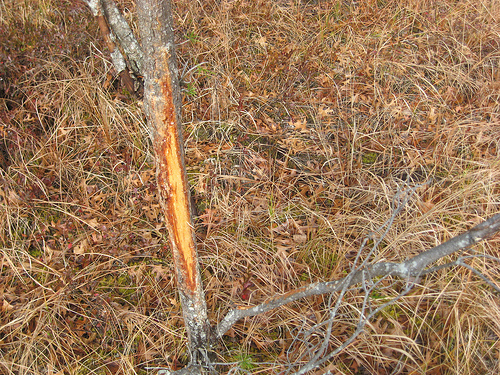Hunters that have been out in the woods early this fall have undoubtedly bumped into some fresh rubs created by white-tailed bucks. Often times, discovering a new buck rub is enough to get my mind thinking about the deer that left the sign. How big is this whitetail? When was the animal here? Does he prefer the habitat found on this part of the property more? Where is the buck now? And, of course, will he return?
The general thinking on deer rubs is that big bucks rub actual trees and small bucks rub on saplings. This line of thinking suggests that the bigger the tree rubbed the bigger the whitetail buck doing the rubbing. Is this true? I would have to say yes, at least most of the time. The majority of bucks rubbing on larger trees are in fact larger antlered bucks. Bucks with large antlers tend to be larger bodied, mature, stronger, and as a result of all these attributes, dominant animals.
But that does not mean that large bucks will not rub on saplings, or that smaller bucks will not rub on decent-sized trees. In nature anything can happen, but the general rule of thumb is that larger white-tailed bucks will create larger rubs. If you find a rub on a tree greater than 10 inches in diameter, chances are you have a very big buck in the area.
Although many deer hunters have never really though about it, a buck rub is an interesting sign left by a deer for one of many reasons. As a matter of fact, buck rubs have different meanings at different times of the year, and hormones always play a role. Rubs created in very late summer and early fall are made in order to remove the decaying velvet from their hardened antlers after the completion of antler growth.
In early fall, bucks will continue to rub primarily on saplings and smaller trees due to increasing levels of testosterone. Elevated levels of this hormore will increase aggression in white-tailed bucks, so the act of antler rubbing not only relieves this stress build up, but prepares the deer for battle by strengthening neck muscles.
As fall progresses and the whitetail rut nears, bucks will take their workout to the next level by seeking out larger trees for larger, more dominant looking rubs. A large rub then serves as a visual and olfactory (smell) sign to other bucks in the area. In short, if you can’t make a rub as big as the one you see here, then hit the road unless you’re ready to throw down.
Some bucks make only a few rubs within their home range, while others make numerous rubs within a very small area. It is difficult to estimate the number of bucks using an area by the number of rubs, but rubs are a sure sign that at least one buck is in the area. Additionally, if given the choice between hunting a buck rub or a buck scrape, choose the scrape every time. And remember, healthy deer with big bodies grow larger antlers, not the other way around!
